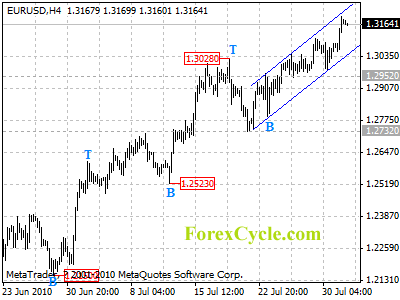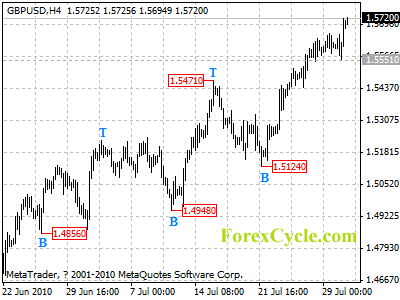Source: ForexYard
Riskier currencies like the EUR and U.K. pound made significant gains against both the Yen and U.S. Dollar in overnight trading, as the markets prepare for a heavy trading week. Traders will want to pay attention to a number of news events today, and should keep in mind that the all-important U.S. Non-Farm Employment Change is set to be released on Friday.
Economic News
USD – Dollar Remains Low vs. European Currencies
While the USD has halted its most recent slide against the Yen, it is still tumbling against both the British Pound and EUR. Since the market opened for the week, EUR/USD has gone up some 30 pips, and is currently trading around the 1.3080 level. Analysts attribute the Dollar’s losses to a continuous stream of negative U.S. news events. That trend seems likely to persist, as we take a look at some of the economic indicators likely to impact Dollar pairs today.
The U.S. ISM Manufacturing PMI, set to be released at 14:00 GMT today, is forecasted to show a drop in the expansion of the manufacturing industry from last month. While the PMI is still expected to show industry growth, a drop from last month will likely negatively impact investor confidence in the U.S. economic recovery. Should the report come in at its predicted figure of 54.2, the Dollar may see further losses.
Shortly after the PMI figure is set to be released, Fed Chairman Bernanke is scheduled to give a speech regarding the challenges facing the U.S. economy. While no major announcements are forecasted, even the slightest indication about where the economy is heading could create heavy volatility for Dollar pairs. Traders will want to pay close attention to the speech. Should the Fed Chairman give a positive economic assessment, the Dollar may be able to recoup some its most recent losses.
EUR – Euro Looks to Prolong Gains against the Dollar
As markets opened for the week, the EUR shot up against the safe haven Dollar and Yen, while taking steep losses against the Aussie. EUR/USD and EUR/JPY are up 30 and 40 pips respectively since markets opened. EUR/AUD on the other hand, is down about 50 pips in the same amount of time.
Analysts are quick to point out that the EUR gains have more to do with the troubles in the U.S. economy, and less to do with any positive European economic indicators. What this means for traders, is that any gains the EUR has made on the Dollar or Yen are tentative at best. With a busy trading week just getting started, any economic indicator that could come in above or below expectations could cause volatility for the EUR.
Today, EUR traders will want to pay attention to the manufacturing PMI’s from both the U.K. and U.S. Both PMI’s are forecasted to show expansion in their respective manufacturing industries. If the reports come in as predicted, the EUR may be able to extend its recent gains as investor confidence is likely to be boosted. At the same time, an unexpected drop in either PMI figure could lead to a wave of risk aversion, and may boost the Dollar.
JPY – Yen Erases Most of Last Week’s Gains
Starting off the week, the Yen gave up most of its recent gains as riskier currencies have begun to assert themselves in the marketplace. The U.K. Pound has moved up close to 50 pips against the Yen since markets opened, while AUD/JPY had gone up over 60 pips before staging a slight correction. USD/JPY has been trading at a relatively steady rate since late last week, and will likely continue to do so as long as risk taking dominates the market place.
Today, Yen traders will want to pay attention to both the U.S. ISM Manufacturing PMI, as well as Fed Chairman Bernanke’s speech. While neither of these indicators directly affects the Japanese economy, their results will heavily influence the status of safe haven currencies like the Yen.
Crude Oil – Oil Prices Continue to Move Up
The weak Dollar has prompted more investment in Crude Oil, leading to steadily increasing prices for the commodity over the last few days. Currently, crude is trading around the 79.20 level, up from around 77.10 on Friday. As the Dollar continues to fall against many of its main currency rivals, traders can expect oil prices to rise.
Today, Crude prices will largely be determined by the Fed Chairman’s speech, scheduled to be given at 14:15 GMT. Should the speech paint an optimistic picture of the U.S. economy, oil prices may drop if investors decide turn back towards the Dollar. On the other hand, if the Fed chairman decides to highlight the continued challenges facing the U.S. economic recovery, oil will likely increase its gains in the marketplace.
Technical News
EUR/USD
Friday’s trading left the pair in a doji candlestick pattern highlighting traders’ inability to push the pair higher. However, the bears were also contained by a short term trend line that began on July 1st. A rising wedge pattern has formed on the hourly chart. Traders may want to target the upper line of the wedge near the price of 1.3120.
GBP/USD
The currency continues to move higher and is showing signs of a pair that is trending higher. The ADX (14) reads 45, indicating a pair that is in a trending phase. Also the 20-day moving average line is sloping up, indicating that the trend is higher. Traders should be long on the pair with a first target the 1.5820 resistance level on the daily chart.
USD/JPY
The pair is also trading in a strong trending environment, supported by a perfect order. The currency is trading below the 200-day simple moving average (SMA), followed by the 100 SMA, 50 SMA, 20 SMA, and 10 SMA in that order. As such, traders should be shorting the pair. Since a breakout of the bearish flag pattern, the pair breached below the support level of 86.25 and fell to a low of 85.93, but traders were unable to make a close below the support level. The next support for the pair comes in at the November 2009 low at 84.90. This should serve as the next target for traders
USD/CHF
While the pair has been range trading for quite some time now, some upward movement may be expected today. A bullish cross is evident on the hourly chart’s Slow Stochastic while the RSI for the pair is floating in the oversold territory on the 4 hour and 8 hour charts. Furthermore the MACD for the pair is the lower range on the 2 and 4 hour charts. Going long with tight stops may be advised for the day.
The Wild Card
AUD/NZD
After a steep rise over the past few days, the pair may be seeing some downward correction during today’s trading. The RSI for the pair is floating in the overbought territory on the 4 hour, 8 hour and daily charts while a bearish cross is evident on the daily chart’s Slow Stochastic. Furthermore, a breach of the upper Bollinger Band is evident on the daily chart, indicating an imminent downward movement. Forex traders may be advised to go short for the day.
Forex Market Analysis provided by Forex Yard.
© 2006 by FxYard Ltd
Disclaimer: Trading Foreign Exchange carries a high level of risk and may not be suitable for all investors. There is a possibility that you could sustain a loss of all of your investment and therefore you should not invest money that you cannot afford to lose. You should be aware of all the risks associated with Foreign Exchange trading.



